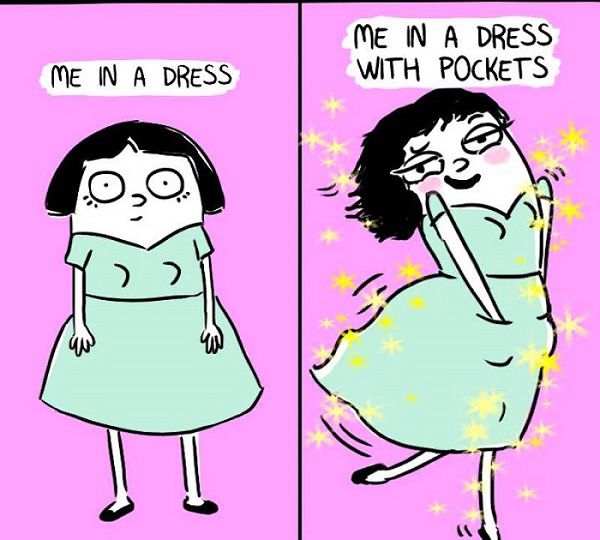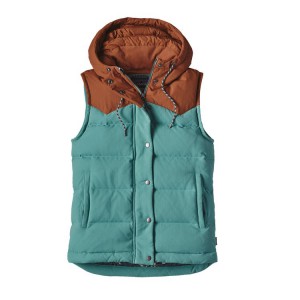
The absence of useful pockets in contemporary women’s clothing is an issue of gender equality and justice that deserves the attention of feminists everywhere.
Did we just see you roll your eyes? Well, come on, hear us out.
One might be tempted to dismiss this as a ‘non-issue’ and a frivolous distraction that caters to only a particular segment of women (read: white, upper class, cis women), especially given that we continue to live in a world where we face violations of our rights and freedoms far more severe than not being able to find clothes with functional pockets.
Writer Tanya Basu recently made an emphatic case for why we must take care not to give in to this line of thinking because the lack of pockets is symptomatic of the larger problem confronting women in this globalised market economy, namely how patriarchal norms around gender and sexuality continue to drive women’s fashion (and lives) in the 21st century. This link between women’s clothing and patriarchy is important to acknowledge and understand if we are to address some pertinent questions around women’s agency and ability to exercise control over their choices, bodies and sexuality – questions that feminists around the world, including in South Asia, continue to struggle with.
Our conversations with friends and colleagues on this subject revealed that while they had thought of the inconvenience caused by absence of pockets, whether in Indian clothing or in ‘western’ styles, it wasn’t something that they had explicitly discussed within their networks. In fact, one of our friends, who perhaps was discussing this for the first time with anyone, exclaimed in exasperation over dinner one evening, “Even trousers don’t have pockets anymore!” indicative of the disbelief (widely prevalent, we assume) that even trousers had to be abandoned at the altar of pocketless and inconvenient clothing, apparently in exchange for style and aesthetics.
We’re not ones to argue that a return to some fictional ‘golden age’ is (ever) beneficial for women. But it’s worth noting that historically in many regions, it was the norm for both women and men to have a sort of large pocket cum small purse sewn into or hidden underneath their clothing. According to fashion historian Barbara Burman, women considered these pocket bags an essential symbol of their “personal space”, given that most people lived in close proximity with others, especially in urban environments, and pockets were the only thing women could use to store their private and personal possessions.
By the 19th century, with the cementing of rigid patriarchal gender roles, women’s pockets had largely disappeared from the scene. The new assumption was that women didn’t need to carry anything of their own since their husbands would be taking care of all their needs. The emerging ideal of a thin (but curvy) body type and the sleek, form-fitting gowns that followed helped reinforce the idea that the appropriate expression of women’s sexuality through fashion was to please and attract men.
Basically, patriarchy: 1.
Pockets aka women’s comfort and convenience: zero.
But it’s telling that to a large degree women are now using social media pages and handles dedicated to feminism and women’s rights to express their discomfort or even disgust with the lack of pockets and general functionality in their clothing. On Twitter, women use hashtags like #DemandPockets as an outlet to not only express their love for pockets and collective disappointment about a lack of them in their clothing, but also to hold the fashion industry accountable and demand an answer to their requests that pockets not be considered a ‘luxury’ for women.
The attempt to connect this sartorial concern with other feminist social media activism is not accidental or a mere fad, but indicative of how feminists are increasingly using these online platforms to talk more openly about issues that have been long held as too taboo and controversial to be spoken and discussed out loud, whether it’s talking about sexuality and pleasure, or sharing women’s experiences of discriminatory attitudes and double standards that they face, including body shaming and public scrutiny of their clothing.
Pockets are just one example of this discrimination, but one that appears to resonate especially strongly. A notable example is the response to web comic Loryn Brantz’s July 2016 piece, also the cover image for our article. The artist juxtaposed an illustration of how “stoic and unhappy” she felt wearing an ordinary dress as compared with her dynamic avatar full of “happiness, pride and sensuality” when donning a dress with pockets. The post swiftly garnered more than 16,000 likes and 17,500 shares (last we checked) from people around the world who knew exactly how Brantz felt in that second dress.
To return to the thought we expressed at the outset, we’re sometimes reluctant to bring out concerns over things like insufficient pockets since there is a tendency to create a ‘hierarchy of issues’ in feminist activism. Even if we’re using the example of non-functional clothing to highlight the seriousness of pervasive gender-based discrimination, opportunities for nuanced dialogue about the matter rarely occur given objections that this focus distracts attention from ‘real issues’.
When women protest restrictions imposed on their dress and movement, these concerns are often dismissed as being relevant only to elite women, who we assume have greater latitude in what they buy and wear. Writing about reactions to attire-based feminist acts in India – a SlutWalk held in Delhi, and the Pink Chaddi Campaign in which protesters sent pink underwear to right-wing extremists Sri Ram Sena to agitate against the group’s attack on pub-going women in Mangalore – Ratna Kapur shows[1] how some perceive the right of women to dress as they wish ranked at the very bottom of issues women confront.
Commentators criticised the SlutWalk Delhi effort as narcissistic indulgence and a Western import that can hardly be important when Indian women are confronting sex-selection, dowry murder, ‘honour’ killings, domestic violence and other horrors. But as Kapur puts it, “The comments tell us more about what little regard there is for women’s demands for sexual autonomy articulated as integral to the pursuit for freedom from violence, than it does about SlutWalk as a mindless and non-serious enterprise.” The political effects of such efforts, moreover, can be far-reaching. In 2014, Sri Ram Sena’s leader Pramod Muthalik was swiftly booted out of the BJP when concerns arose that the Mangalore pub violence and his handling of the Pink Chaddi protest would not endear him to women voters.
This said, it’s important to consider the class dynamics of women asserting their right to dress and occupy spaces in the way they wish, and the ways in which clothing designers are beginning to respond to these demands. Changes in clothing designs that feature usable pockets is one possible positive outcome of “consumer agency” as women talk back assertively to “inherent sexism” within the fashion industry.
As with any market-based solution that promises to further ‘liberate’ women, we need to examine the underlying motivations of designers with a critical eye, and take note of exactly whose requests are being heard. Some of the recent push for bigger, more practical pockets results from new challenges toting technology, namely smartphones and ‘phablets’ (a portmanteau of ‘phone’ and ‘tablet’, and sized accordingly) items that are becoming ever more affordable but are not yet universally accessible.

In addition, many of the noticeable changes in garment functionality are occuring in expensive ‘athleisure’ and high-tech outdoor brands (like the vest in the image). These are clothes meant to easily toggle among casual office wear, hanging out with friends, and exploring a rugged mountain trail, but their price point means a narrow customer base (think San Francisco post-gentrification). Comfort and utility, for women at least, bear a hefty entry fee.
The hidden cost of this entry fee isn’t paid off when you plunk down half a paycheck for waterproof wedge booties that promise to fix both your posture and your social anxiety (and as a ‘side benefit’ might actually keep your feet dry in a monsoon).
For Indian women, middle-class status does not necessarily mean autonomy, but might instead invite harsh surveillance. Feminist professor Shilpa Phadke writes[2] that the spaces in which women are most visible are spaces of consumption like shopping malls, places that masquerade as public but are actually still private and subject to patriarchal familial norms.
The cost of women’s admission to these spaces requires not just the pricey costume of a potential consumer, but also the circumscription of their behaviour. Phadke makes the bold point that all women in urban India are part of the ranks of “unbelongers”, independent of their family’s class/caste/religion status. Along with other marginal citizens – migrant workers, Muslims, Dalits, the poor, the queer, the disabled, North-Easterners, and more – women’s presence in public is at best grudgingly accepted but often met with disciplining and violence. Case in point among (many) recent examples, women are body-shamed and slut-shamed for wearing shorts and humiliated in media for visible bra straps – ask just about any woman, and you’ll receive countless narratives of the misogynistic ways we’ve been scolded or worse for perceived infractions in our attire.
Combined with the degree of harassment and resistance many women experience when they are using public spaces as they wish, the technical limitations of our clothing start to seem less like little annoyances to be brushed off, and more like amplifications of the discrimination we experience at home, at school, and in the workplace.
We need to affirm that there are no
‘real’ and ‘trivial’ instances of discrimination:
the question is just one of degree.
We should not overlook the social cues embedded in mainstream fashion that make it a hassle for women to travel and confidently assert their right to belong outside of the home. Performing the ‘socially acceptable’ trappings of femininity such as lugging a shoulder-wrenching big handbag and wearing impractical clothing made of flimsy fabrics adds layers of challenge to women navigating unfriendly, sometimes hostile urban geographies that were not designed with them in mind. Shoving these concerns aside in favour of addressing ‘real issues’ rather than connecting the dots among pervasive and seemingly intractable instances of discrimination weakens feminist strategies.
Also, we effing love pockets. Deep ones, with sturdy linings. In our pants but especially in our skirts and dresses (always a surprise and a delight). We crave them in the clothes that we wear for dancing and running, for celebrating graduations, new jobs, and weddings. We use pockets to keep condoms and love notes close to our bodies, not because we’re embarrassed for others to see these things but because we enjoy the intimacy of these objects getting warm from our bare skin under pocket lining, along with pens, river pebbles, and other cherished objects, near enough that we can reach in and squeeze them at will, grazing their energy and potential with curious fingertips.
Perhaps most important, we require pockets in our attire for lounging, for being still on a park bench or nestled in grass, and reading a book alone. Pockets are essential for a carefree – but politically potent – afternoon of loitering, an activity oriented around pleasure and not consumption. When enjoyed by women and other “unbelongers”, Phadke opines, loitering is a kind of “urban anarchy” representing the “possibility of redefining the terms of their access to public space, not as clients seeking protection but as citizens claiming their rights.”
Suffice it to say, we agree. How do you use your pockets?
इस लेख को हिंदी में पढ़ने के लिए यहाँ क्लिक करें।
Cover Image: Loryn Brantz
[1] Ratna Kapur, “Pink Chaddis and SlutWalk Couture: The Postcolonial Politics of Feminism Lite,” Feminist Legal Studies 20 (2012), 14.
[2] Shilpa Phadke et al, “Why Loiter? Radical possibilities for gendered dissent,” in Melissa Butcher and Selvaraj Velayutham ed., Dissent and Cultural Resistance in Asia’s Cities (New York: Routledge, 2009), 193-194.